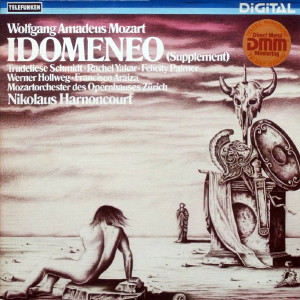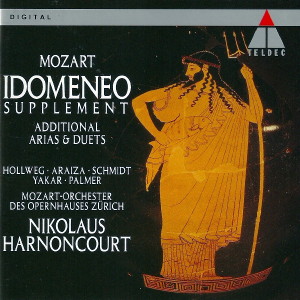 |
1 LP -
6.42650 AZ - (p) 1982
|

|
| 1 CD -
4509-95983-2 - (c) 1994 |
|
Wolfgang Amadeus
Mozart (1756-1791)
|
|
|
|
|
|
|
|
Idomeneo, KV 366
(Supplement)
|
|
|
|
|
|
|
|
Atto terzo, in Scena IX: No.
27a, Aria (Idamante) "No, la morte"
*
|
5' 28" |
|
A1 |
Atto terzo, in Scena II; No.
20b, Duetto KV 489 (Ilia, Idamante)
"Spiegarti non poss'io"
|
3' 40" |
|
A2 |
Atto secondo, in Scena I:
No. 10b, Scena con Rondo KV 490 (Ilia,
Idamante) "Non più. Tutto ascoltai"
**
|
11' 05" |
|
A3 |
| Atto terzo, in Scena X: No.
29, Aria (Elettra) "D'Oreste, d'Aiace" |
6' 52" |
|
B1 |
Atto terzo, in scena ultima:
No. 30a, Aria (Idomeneo) "Torna la
pace"
|
7' 23" |
|
B2 |
Gavotte
|
3' 14" |
|
B3 |
|
|
|
|
Werner
Hollweg, Idomeneo, re di
Creta
|
|
Trudeliese
Schmidt, Idamante, suo
figlio *
|
|
| Francisco
Araiza, Idamante, suo
figlio |
|
Rachel
Yakar, Ilia, principessa
Troiana; figlia di Priamo
|
|
Felicity
Palmer, Elettra,
principessa; figlia d'Agamennone,
re d'Argo
|
|
|
|
Frank Gassmann, Solovioline
**
|
|
| Mozartorchester
des Opernhauses Zürich
(Mitglieder des Tonhallen- und
Theaterorchesters) |
|
|
|
| Nikolaus
Harnoncourt, Gesamtleitung |
|
|
Luogo e data
di registrazione
|
| Neue Kirche Albisrieden,
Zurigo (Svizzera) - marzo e giugno 1980 |
|
Registrazione
live / studio
|
| studio |
Producer / Engineer
|
Heinrich J. Weritz
|
Prima Edizione
CD
|
Teldec - 4509-95983-2 - (1 cd)
- 38' 33" - (c) 1994 - DDD
|
Prima
Edizione LP
|
Telefunken - 6.42650 AZ - (1
lp) - 38' 33" - (p) 1982 - Digital
|
|
|
Notes
|
This
recording comprises a
supplement to Nikolaus Harnoncourt`s
Idomeneo
(TELDEC 2292-42600-2), which
presents the opera in the
version followed at the
Munich première
in 1781, as contained in
Daniel Heartz's
edition in the Neue
Mozart-Ausgabe.
The latter recording,
therefore, does not include
the numbers in Idomeneo
that Mozart deleted in the
course of the preparations
for the première
of the work in Munich,
nor of course those passages
that Mozart subsequently
rewrote for the Vienna
performance in 1786. As
Harnoncourt wrote
1980 concerning the total
recording. “Since all the
pieces omitted in Munich. as
well as the passages
rewritten for Vienna,
are wonderful music. we
intend to record them too
and to publish them on a
supplementary disc, so that
all the music Mozart
composed for Idomeneo
is accessible in one
interpretation."
We are well acquainted with
the circumstances
surrounding the creation of
Idomeneo, thanks not
only to the surviving
textual and musical sources,
but also to the particular
constellation of
personalities involved,
directly or indirectly, with
the opera First of all the
librettist Giambattista
Varesco, a chaplain at the
Salzburg court, who has
commissioned to work the
ldomeneo matertal into an
operatic libretto according
to a "plan" evolved by the
directors of the Munich Hoftheater;
then the composer's father
Leopold Mozart, who was also
in Salzburg during the
decisive phase of Idomeneo's
composition; finally
Wolfgang Amadeus
Mozart himself, who had
certainly already composed
some parts of the work in
Salzburg, but then travelled
to Munich on 5th
November 1780 to write most
of the opera “on the spot",
and constantly corresponded
with his father in Salzburg
from his arrival in Munich.
A first batch of revisions,
which Mozart had Varesco
make to his libretto, using
his father as ‘middle-man’,
is not musically acccssible,
since the alterations were
made before Mozart set the
libretto to music. Mozart
was then obliged to make
cuts in those passages he
had already composed during
the rehearsals and
last-minute preparations for
the première.
These cuts affected
recitative parts in all
three acts, which, as they
do not constitute
independent items, are not
included on this record.
Likewise. we have omited
from this supplement the
three rejected versions of
the oracle's
decree and the passepied
from the ballet music - the
gavotte, however which
Mozart wrote down along with
the ballet music. has been
included, although we do not
know at what point in the
opera it was supposed to be
played.
Mozart took the most drastic
steps to tighten up the work
in the third act: here no
less than three complete
numbers fell victim to his
red pencil.
This applies to Idamante's
aria "No,
la morte io non pavento",
which was originally sung in
scene 10,
at the point when Idamante,
alreadv prepared to
sacrifice his life, urges
his father Idomeneo to
accept his beloved Ilia as
his daughter-in-law: "s’ella
sposa non m’è,
deh siati figlia". Idomeneo's
aria "Torna
la pace",
which occurred immediately
before Idamante's
coronation in the final
scene, was also cut, Mozart
justified both omissions on
dramaturgical
grounds: “The rehearsal of
Act Three went splendidly. It
was established that it is
still much longer than the
first and second acts -
there is too much text, and
accordingly too much
music... so
Idamante’s aria "No,
la morte io non pavento" is
to be left out. It’s
clumsy in that position
anyway
- but
the people who have heard
the music sighed over its
omission; I’m
also cutting Raaff's last
aria, which caused even more
sighs - but
one has to make a virtue out
of necessity."
Mozart made another cut in
Elettra's last scene, whose
original dramatic
concept had troubled him for
a long time. He
replaced the aria "D`Oreste,
d’Aiace" with a new
obbligato recitative, "0h
smanial oh furie!!"
Elettra's aria seems
dispensable in terms of
content, since it only
conveys information already
known. "Mozart made the
requisite out in a congenial
fashion and composed a short
but incomparably
fiery recitative with the
exit of Elettra,
which must be
one of the most
dramatic in the whole opera”
(Daniel Heartz).
After several attempts to
produce Idomeneo in
Vienna during Mozarts period
in the Austrian capital had
miscarried, he managed to
arrange a performance at
Prince Auersperg's in 1786.
However, as the date fixed
fell during Lent, only a
concert performance could be
given, and Mozart thus had
to make a numher of changes,
since the pan of Idamante,
conceived in Munich for the
castrato Vencenzo dal Prato,
was sung in Vienna
hy a tenor. Mozart made
further major
alterations to the munich
score in two places, not
only out of consideration
for the east but
also for dramaturgical
reasons. He substituted for
the first scene of Act 2
with Arbace's
aria “Se il tno vuol", a
weak point of the Munich
score from a theatrical
point of view
the Scena con Rondo Ilia/Idamante,
K. 490, which he completed
on 10th March 1786, three days
before the performance. By
replacing the first scene
with Arbace’s
aria - superfluous to the
plot - by
the recitativo accompagnato Ilia/Idamante,
with Idamante's
aria "Non
temer; amato bene"
following. Mozart lends
Idamante, one of the operas
main characters, greater
significance. Mozart wrote
the violin solo in K. 490
for his friend Graf
Hatzfeld, who was involved
in the performance. and was
an excellent violinist. The
second major encroachment on
the Munich score affected Ilia and
Idamante's love duet in
Act 3,
soene 2. Mozart
replaced the original
hundred-bar composition with
a duet only 39
bars in length, "Spiegarti
non poss'io". The duet in
the Munich version had, as a result
of
the text, become too light,
dance-like
and frivolous. "The two
lovers change into Papageno
and Papagena",
writes Daniel Heartz, "a
a point where.
in view
of their impending ordeal,
they should show more
gravity than even and the
strength of Tamino and Pamina."
Mozart corrected
the deficiency with a duet
which had il new text and
mostly new music, writing at
seamless piece that acts as
a "drawn-out emotional
crescendo" (Heartz),
preparing the two lovers and
the audience alike for the
violent emotions to come.
Dietrich
Berke
Translation:
Clive R. Williams
|
|
Nikolaus
Harnoncourt (1929-2016)
|

|

|
|